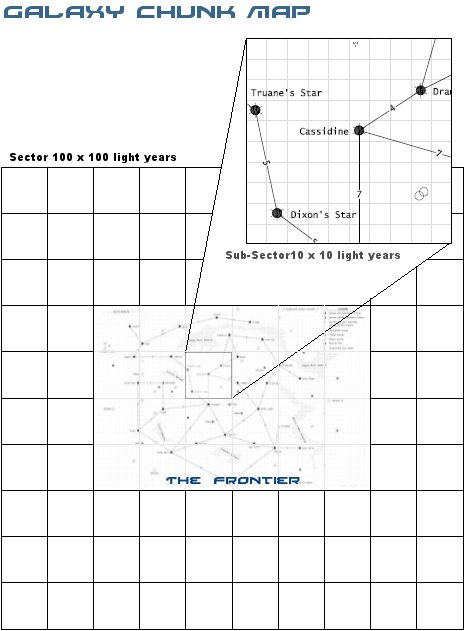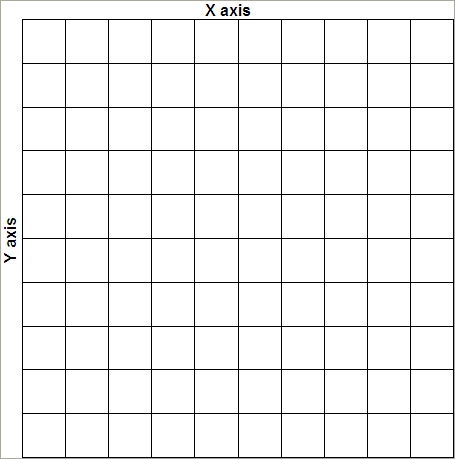The Froniter Sector
The Frontier is a big place of tightly packed systems teaming with life. The Froniter is also an odd-shaped place as far as mapping is concerned. It measures 60 light-years wide by 40 light-years high. I've toyed around with some ideas to name the Frontier using mapping language and came up with what I think would be the most universal name... for the Frontier, The Frontier Sector.
Kinda catchy, eh?
The Frontier Sector is simply the explored and un-explored region mentioned above. I came up with the 60x40 light-years span using Alpha Dawn and Zeb's Guide as a reference. Now, when attempting to expand the Frontier it would be helpful to allow for a square Frontier so that rolling up random systems adjacent to the Fronter Sector they could fit nicely, but that leaves about 120 light-years of uncharted area which by the defintion above is not part of the Frontier Sector.
The solution required the definition of a "sector".
The following was kicked around the room;
Attempting to define sector definition.
1 x 1 light-year (too small scale)
10 x 10 light-years (still too small scale)
60 x 40 light-years (better but odd shaped and unuseable)
100 x 100 light-years (large but useable and our choice)
Introducting "Sector Map by Number"
Definitions :The Frontier Sector = 60x40 light-year area
S = Sector
Ss = Sub-sector
LY = Light Year
Sizes :
Sector = 100 x 100 LY
Sub-sector = 10 x 10 LY
Using Alpha Dawn and Zeb's Guide as a reference the Frontier map is measured in light years. Starship routes are calculated by determining the light years between stars. The Frontier map is approximatley 66LY wide by 42LY high or 6 x 7 sub-sectors.
This map shows a Galaxy Chunk Map measuring 100 x 100 light years

Rolling up new star systems.
To determine the number of star systems in a sub-sector use the table below. Roll 1d10 to determine the number of star system in the sub-sector. Then roll 1d10 to determine the X axis. Roll 1d10 to determine the Y axis and mark the star on the map.

Example Sub Sector Map.
Rolling 1d10 I came up with a 7. This is the number of star systems in my sub-sector. Now rolling to place each star, I use 1d10 for the X axis followed by 1d10 for the Y axis I mark the map as follows.
Results :
Roll x = 4
Roll y = 2
Place a star system at 4, 2.
Repeat for each star system.
| Y--X | 1 | 2 | 3 | 4 | 5 | 6 | 7 | 8 | 9 | 0 |
| 1 | 0 | |||||||||
| 2 | 0 | |||||||||
| 3 | 0 | |||||||||
| 4 | 0 | 0 | ||||||||
| 5 | 0 | |||||||||
| 6 | ||||||||||
| 7 | ||||||||||
| 8 | 0 | |||||||||
| 9 | ||||||||||
| 0 |
Generate A System
{List:SYSTEM}
dwarf. {BR} Sensor show NO habitable planet(s)
{List:End}
{List:FRONTIER}
Araks
Athor
Cassidine
Dixon's Star
Dramune
Fromeltar
Gruna Goru
K'aken-Kar
Kizk'-Kar
Madderly's Star
Prenglar
Scree Fron
Theseus
Timeon
Truane's Star
White Light
{List:End}
{List:FEATURE}
Some unknown creature, able to life in deep-space {OBJECT} without the need for life-support is found.
No special feature.
An alien device which appears to be a {DEVICE} floats in space {OBJECT}.
The system has been drastically altered or manufactured by unknown beings. {ARTIFICIAL} looms in the forward viewscreen.
Sensors pick up a mirror system. This system has everything that {FRONTIER} has...but without sentient beings.
A flock of space geese trveling in-system.
A space mirage which looks like a {DEVICE}.
{List:End}
{List:OBJECT}
orbiting a moon
orbiting a planet
living on a moon
following a comet
orbiting a very large asteroid
in the orbital path of an asteroid field
orbiting the home star
{List:End}
{List:DEVICE}
mine
ship
hulk
probe
{List:End}
{List:ARTIFICIAL}
An artificial planet
An artificial planet and artificial moons
An artificial planet
An artificial asteroid belt comprised of unknow origin
A ringworld
A Dyson sphere around the home star
A Dyson ring around a planet
{List:End}
{List:CelesitalObjects-small}
comets
asteroid belt
ice ball
{List:End}
{List:COMETS}
short-period comets
long-peroid comets
{List:End}
{List:BELT}
asteroid belt
gas belt
{List:End}
{List:PLANETS}
{BR}jovian
{BR}terrestrial planet
{BR}ice dwarf
{BR}ice ball
{BR}heap of rock
{BR}ocean planet
{BR}brown dwarf
{BR}carbonaceous gas planet
{BR}failed rock core
{BR}green house planet
{List:End}
{List:DISTANCE}
.1 AU
.2 AU
.3 AU
.4 AU
.5 AU
.6 AU
.7 AU
.8 AU
.9 AU
1 AU
1.1 AU
1.2 AU
1.3 AU
1.4 AU
1.5 AU
1.6 AU
1.7 AU
1.8 AU
1.9 AU
2 AU
2.1 AU
2.2 AU
2.3 AU
2.4 AU
2.5 AU
2.6 AU
2.7 AU
2.8 AU
2.9 AU
3 AU
3.1 AU
3.2 AU
3.3 AU
3.4 AU
3.5 AU
3.6 AU
3.7 AU
3.8 AU
3.9 AU
4 AU
4.1 AU
4.2 AU
4.3 AU
4.4 AU
4.5 AU
4.6 AU
4.7 AU
4.8 AU
4.9 AU
5 AU
10 AU
20 AU
{List:End}
{List:MOONCOLORS}
Red
Orange
Blue
Green
Purple
Gray
Black
White
{List:End}
{List:START}
As you come out of the Void you see a {SYSTEM}. {BR}{BR}{BR} As sensors sweep the system several celestial objects appear on the scanners. {BR} About {Roll:11d10} {COMETS} appear on the SystemScope along with a single {BELT}. {BR}{BR} There are {Roll:1d10=planet} planets in this system. {PLANETS#planet}. Distances as follows: {DISTANCE#planet}'s. {BR} {BR} SPECIAL FEATURE = {FEATURE} {BR} {BR}
{List:End}